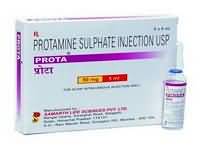CLINICAL USE
Counteract anticoagulant effect of heparin
DOSE IN NORMAL RENAL FUNCTION
Depends on time since stopping IV/subcutaneous heparin and dose of heparin given
PHARMACOKINETICS
DOSE IN RENAL IMPAIRMENT
GFR (mL/MIN)
DOSE IN PATIENTS UNDERGOING RENAL REPLACEMENT THERAPIES
IMPORTANT DRUG INTERACTIONS
Potentially hazardous interactions with other drugs
ADMINISTRATION
Reconstition
–
Route
–
Rate of Administration
5 mg/minute
Comments
–
OTHER INFORMATION
Counteracting the anticoagulant effect of heparin during extra-corporeal treatments requires approximately 1.5 mg protamine per 100 IU heparinMost clinicians recommend a dose of 1–1.5 mg protamine sulphate for each 100 units heparin given depending on the length of time since heparin administrationMay be used topically to stop bleeding fistulae

